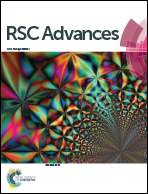Synthesis, electron microscopy and anti-microbial properties of Fe3O4–Ag nanotubes
Abstract
Electrodeposition was used for synthesizing 200 nm diameter Fe3O4–Ag nanotubes. Compositional analysis at the single nanotube level revealed a fairly uniform distribution of component elements in the nanotube microstructure. As-synthesized Fe3O4–Ag nanotubes were superparamagnetic in nature. Electron diffraction revealed the ultrafine nanocrystalline microstructure of the nanotubes. The effect of Ag on the anti-microbial response of the nanotubes was investigated by comparing the effect of sulphate reducing bacteria (SRB) on Fe3O4–Ag and Fe3O4 nanotubes. Fe3O4 nanotubes were also electrodeposited in the present study. It was observed that the Fe3O4–Ag nanotubes exhibited good resistance to sulphate reducing bacteria which revealed the anti-microbial nature of the Fe3O4–Ag nanotubes.


 Please wait while we load your content...
Please wait while we load your content...